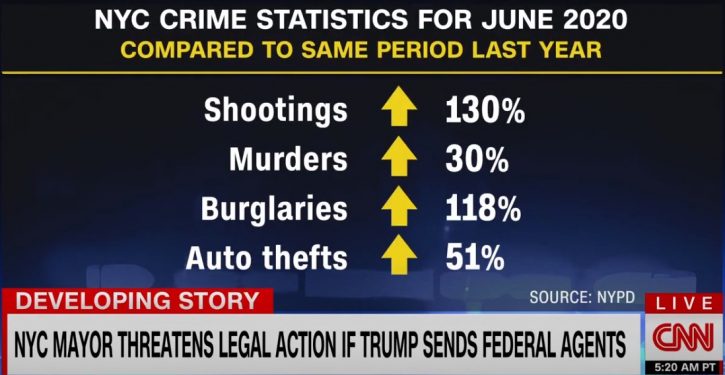
Advocates of shorter sentences for criminals make two claims that contradict each other. First, they say violent crime and organized shoplifting aren’t increasing. Second, they say violent crime is rising, but it’s all due to the coronavirus epidemic. But the homicide rate has indeed gone up, for reasons unrelated to the coronavirus epidemic.
The New York Times reported on September 22 that “murder rose by almost 30% in 2020,” and is still “rising at a slower rate” today. The Times was citing the FBI’s Uniform Crime Report. This increase is not a normal fluctuation in the crime rate: “There is no precedent for last year’s increase in the number of murders,” The Times said. “The United States in 2020 experienced the biggest rise in murder since the start of national record-keeping in 1960, according to data gathered by the F.B.I. for its annual report on crime.”
Yet advocates of leniency toward criminals — who claim to be “data-driven” “criminal justice reformers” — deny there is any increase in violent crime. Samuel Sinyangwe wrote today that “The ‘shoplifting wave’ is entirely fake. Violent crime rates didn’t ‘spike’ either.” Despite the nearly 30% spike in the murder rate.
Sinyangwe prides himself on supposedly being “data-driven,” and describes himself as a “Data Scientist & Policy Analyst” who studies “police violence.” (He also calls himself a “black activist”). But the data directly contradict his claim that “violent crime rates didn’t spike.” The FBI says murder rates are rising, and even the liberal New York Times concedes that homicide rates have skyrocketed.
Rather than taking issue with Sinyangwe’s false claim, more than 665 people retweeted his false claim with approval. The 665 people included law professor Rachel Barkow. Her book, “Prisoners of Politics: Breaking the Cycle of Mass Incarceration,” is often touted by people who want to cut sentences for violent criminals. Sinyangwe’s false claim was also tweeted by the senior vice president of a think-tank. Barkow gave the annual lecture at that think-tank’s annual event. Another manager at that think-tank also retweeted this false claim.
Ironically, in August, that think-tank admitted that violence was in fact increasing, but said, “The most likely explanation for 2020’s increased homicides likely lie with the effects of the COVID-19 pandemic.” That is not the explanation: The COVID-19 pandemic was a worldwide phenomenon, yet homicides fell in most of the world — even countries with higher death rates than the United States (that’s true regardless of whether you use official COVID-19 death rates, or excess death rates taking into account unreported COVID-19 deaths).
In 2020, the murder rate fell in Peru, which had a COVID-19 death rate over twice as high as America’s. Peru has the world’s highest official death rate from COVID-19: about 6,000 per million people, compared to about 2,400 per million people in the U.S. Murders also fell in Mexico, which had an official COVID death rate per million similar to America’s, and an unofficial (true) death rate nearly twice as high. Murders also decreased in Russia, which has an unofficial (true) death rate from COVID-19 that is over twice as high as America’s.
In October 2021, the Cato Institute again admitted that murders had risen, but speculated that “the COVID-19 pandemic, which made 2020 an aberration in so many ways, could be at the root of the increased murder rate….Advocates of increased incarceration counter that, unlike the United States, many international jurisdictions saw decreased murder rates despite the pandemic, but these accounts do not acknowledge that many international jurisdictions had stricter lockdown policies, often including curfews.”
But it wasn’t just countries with curfews that had declining murder rates. Nations that did not have lockdowns also experienced falls in their homicide rates. Homicide fell in both nations with strict lockdowns, and nations without strict lockdowns. The Cato Institute did not point to a single nation without strict lockdown policies that had a rising homicide rate. Lockdowns cannot explain variations in the homicide rate if murder rates fell even where there was no lockdown.
Organized shoplifting and robberies are increasing. Fox News reports that smash-and-grab looters targeted stores across the country over Thanksgiving and Black Friday. They robbed stores of thousands of dollars in merchandise and killed a security guard in Oakland as he tried to protect a news crew who were reporting on the crimes.
Sinyangwe cites a report in the San Francisco Chronicle that a recent reported doubling in the rate of shoplifting in San Francisco was caused almost entirely by a single Target store using a new system to automate reporting, when there was in fact no more shoplifting than usual at that store. But even if that temporary spike in reported shoplifting was meaningless, it did not mean that shoplifting is not a problem, or even that it is not a growing problem.
In October, Walgreens said it was closing five drugstores in San Francisco that had experienced high rates of shoplifting, attributing the rash of theft to “organized crime.” “Organized retail crime continues to be a challenge facing retailers across San Francisco, and we are not immune to that,” Walgreens spokesperson Phil Caruso said. “Retail theft across our San Francisco stores has continued to increase in the past few months to five times our chain average.” In September, Kroger chief executive Rodney McMullen cited growing “organized crime” as contributing to a financial hit to the largest supermarket chain. Last December, the Washington Post reported on rising shoplifting across America.
Many retailers have stopped reporting most instances of shoplifting to the police, because recently-elected soft-on-crime prosecutors like San Francisco’s Chesa Boudin don’t seek jail time against shoplifters unless they steal thousands of dollars of merchandise from a single store. There is no point for a retailer in spending hours identifying and reporting shoplifters, if shoplifters who steal less than $950 from a single store won’t be arrested or incarcerated. As the San Francisco Chronicle points out, retailers say “leniency in the criminal justice system plays a role” in keeping reports of shoplifting down even as shoplifting has increased, “with stores forgoing reports because they figure people won’t be punished anyway.” As The Chronicle reports:
People expressing alarm about shoplifting, including leaders at major retail associations such as the California Retailers Association, say the crime has grown greatly…driving a wave of store closures citywide. They point to stores cutting their hours and company spokespeople saying that shoplifting and the need for security has increased, and they reference incidents like last weekend’s mass thefts at Louis Vuitton and other high-end luxury goods stores.
They argue that police data will always be inaccurate because in a city that has historically struggled with high property-crime rates, store workers either don’t witness or don’t report most incidents. And they say leniency in the criminal justice system plays a role, with stores forgoing reports because they figure people won’t be punished anyway.
When activists talk about getting rid of “mass incarceration,” what most of them mean is releasing a lot of dangerous criminals. You can’t get rid of most incarceration without releasing a lot of violent criminals. In 2017, the Bureau of Justice Statistics found that 55 percent of state prison inmates in America were there for “violent offenses,” and only 15 percent for drug crimes — mostly drug-dealing, not mere drug possession; only 4 percent of people in state prisons were there for drug possession (it’s an even lower percentage today). And even people convicted of drug possession aren’t usually there just because they used drugs. A lawyer points out that almost “nobody gets arrested for marijuana possession. They get arrested for other things and have the marijuana charge tacked on after they’re searched.” Peaceful pot users almost never go to prison.


